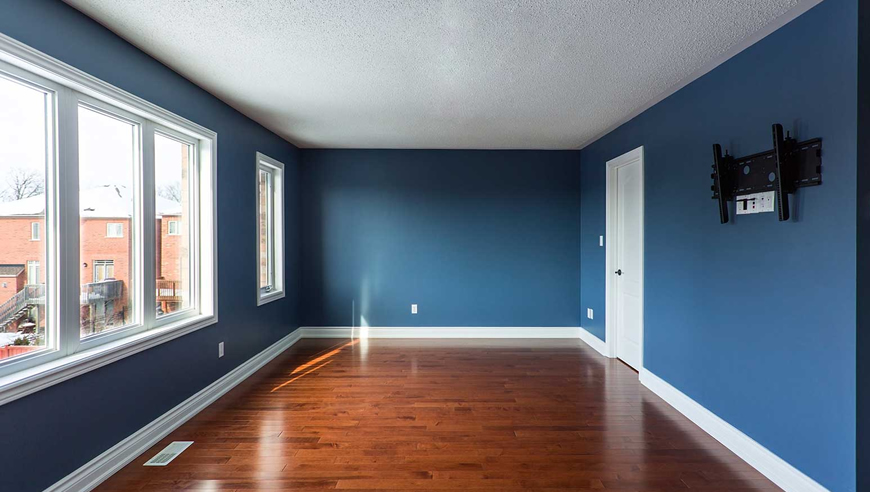Enhance Your Inside Design With Comprehensive Color Examination
The integration of color appointment right into indoor style presents a distinct chance to improve and raise the emotional and visual resonance of a space. By involving with a skilled shade expert, you can navigate the complexities of color choice, ensuring that your selections not just complement building functions but additionally reverberate with personal design and mental impact.
Advantages of Color Appointment

Furthermore, color appointment help in making the most of natural light and enhancing spatial assumption. Lighter hues can make a room appear more extensive, while darker tones develop an intimate setting. Cleveland Metro Painting Specialists. This tactical application of color can substantially affect the total setting of any indoor room
In addition, professional specialists have a comprehensive understanding of current trends and timeless classics, guaranteeing that the selected colors will remain appealing in time. This foresight can save clients from costly redesigns in the future. Finally, shade appointment encourages customers by giving them with a clear vision and instructions, promoting confidence in their style selections and eventually causing a much more successful and enjoyable interior decoration end result.
Understanding Shade Psychology
The relevance of color psychology in interior design can not be overemphasized, as it looks into the emotional and emotional effects that numerous shades can evoke in people. Colors can affect mood, actions, and also productivity, making them a vital consideration in any type of layout job.
For circumstances, warm shades such as red, orange, and yellow are commonly associated with power and warmth. They can stimulate sensations of enjoyment and convenience, making them ideal for social rooms like living spaces or kitchen areas. On the other hand, awesome shades like blue, green, and purple often tend to stimulate calmness and tranquility, making them excellent for bedrooms or reflection locations.
Furthermore, making use of neutral tones can develop a well balanced environment by enabling the bolder shades to stand apart without frustrating the senses. Understanding these mental effects makes it possible for designers to create areas that not just look cosmetically pleasing but likewise advertise psychological health.
Incorporating color psychology right into interior decoration includes a thoughtful option of tones tailored to the intended feature of each space, eventually enhancing the total experience for its occupants. This awareness is important for achieving a unified and practical indoor setting.
The Shade Wheel Clarified
It consists of main colors-- red, blue, and yellow-- that can not be developed by blending various other shades. Tertiary shades result from mixing a main and a second color, leading to tones such as red-orange and blue-green.
The shade wheel aids designers grasp the connections between shades, including corresponding, analogous, and triadic plans. Complementary colors, located contrary each various other on the wheel, create vibrant contrasts that can stimulate a room.
Utilizing the shade wheel in interior decoration not just enhances aesthetic allure but likewise stimulates specific emotions and ambiences, making it an important referral for color examination. Recognizing these relationships eventually encourages designers to produce areas that are both visually fascinating and useful.
Selecting the Right Palette
An appropriate shade system can link an area, boost its attributes, and stimulate preferred emotions. Different spaces serve different functions and require palettes that reflect their desired usage; for circumstances, relaxing colors such as soft blues or greens function well in bed rooms, promoting relaxation.
Light can dramatically modify exactly how colors show up, so it is necessary to evaluate the area at different times of the day. A harmonious combination ought to enhance these functions, creating a cohesive appearance throughout the area.
When selecting colors, make use of the 60-30-10 policy, which suggests that 60% of the area should be a leading color, 30% a second color, and 10% an accent color. This proportion makes sure balance and visual passion (Cleveland Metro Painting Specialists). Lastly, example colors on the wall surfaces before dedicating, as this permits you to see see page exactly how the tones communicate with one an additional and the overall setting they create in your interior decoration project.
Functioning With a Shade Consultant

When dealing with a shade professional, the procedure typically begins with an initial examination. Throughout this conference, you'll review your vision, choices, and the existing aspects in your area. The specialist will assess your needs and might suggest certain color combinations that align with your goals.
After establishing an instructions, the professional will certainly supply samples and visual help to aid you picture the suggested color pattern. Going Here This action is vital, as colors can appear differently under differing illumination conditions.
Additionally, a shade expert can Visit Website direct you in selecting corresponding home furnishings, artwork, and devices to integrate with your chosen scheme. By working together closely, you can attain a refined aesthetic that boosts your interiors and develops an inviting atmosphere. Inevitably, the know-how of a color consultant can dramatically improve the total effect of your design task.
Final Thought
In summary, detailed shade assessment offers as a vital tool for improving indoor design. By leveraging expert understanding of shade psychology and spatial characteristics, a tailored color combination can be developed to evoke certain feelings and develop a harmonious environment.
By engaging with an experienced shade professional, you can browse the complexities of color selection, guaranteeing that your options not only complement architectural functions however additionally reverberate with individual design and psychological effect. It consists of key shades-- red, blue, and yellow-- that can not be developed by blending various other shades.The shade wheel assists designers realize the relationships between colors, including corresponding, similar, and triadic systems.When picking colors, utilize the 60-30-10 policy, which suggests that 60% of the area ought to be a dominant color, 30% a second shade, and 10% an accent color. By leveraging expert knowledge of color psychology and spatial characteristics, a customized color palette can be developed to stimulate certain emotions and create a harmonious setting.